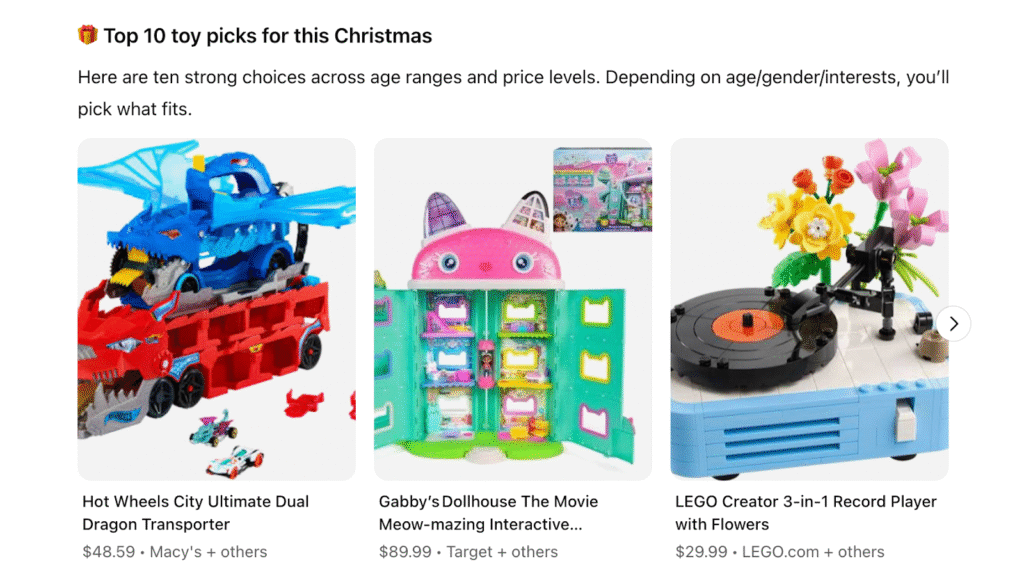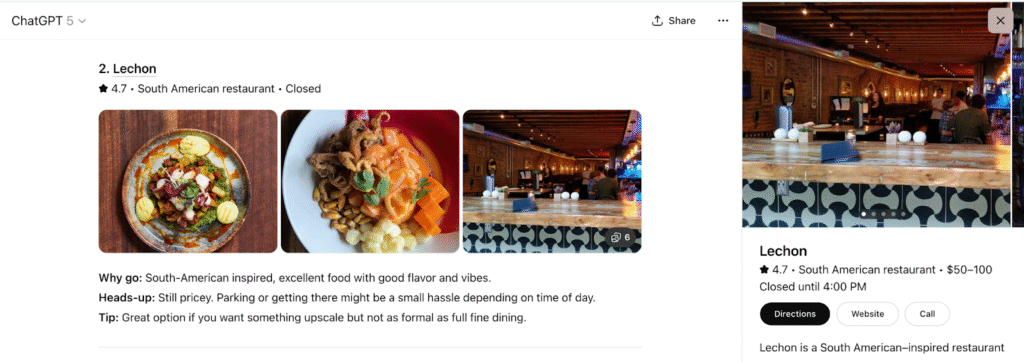I first noticed an interesting ChatGPT feature while demoing my ChatGPT Search Insights tool for Jeremy Galante, who leads SEO at ClickUp, during the Ahrefs Evolve conference a few weeks ago. We were looking into a strategy that he was just rolling out, and we saw this. He said, “Can you screenshot that for me?”
This is what I sent him.

Jeremy is the “growth hacker” kind of SEO, like me, so I have to imagine the same thing was going through our minds. What is this thing, and how can I take advantage of it?
That was on October 14th. Since then, I’ve seen more and more of what I’ve been describing as entities.
In this post, I’m going to share everything I’ve learned about entities, including what they are, how they’re populated, and what that means for, at least, the current state of growth marketing.
Let’s get started with the basics. What are “entities?”
What are entities?
Entities are commonly defined as things that exist and have properties. This is the terminology we’ve been using in SEO for a while and has roots in things like Google’s Knowledge Graph and the Semantic Web (RDF/OWL models). In a digital world, entities are typically represented by objects with identifiers such as names or IDs with associated properties. You’ll often see these described as rows in a database (eg, products) or JSON objects as ChatGPT does in its front-end API.
Take the example above. The screenshot shows two Product entities identified by their name and displayed with their (wildly inaccurate) price property.
You’re probably wondering, “What types of entities does ChatGPT recognize?”
Since I noticed the first entities, I’ve been surprised to find how many entity types there are. On top of that, ChatGPT’s responses provide some evidence of the relationships between entities that would suggest there may be a substantive ontology under the covers.
Let’s dive into ChatGPT’s entity ontology.
ChatGPT’s Entity Ontology
As of the time that I’m writing this post, I’ve noticed numerous distinct entity types in ChatGPT’s responses embedded in the frontend API’s responses. From a marketing perspective, the ones that are most interesting to me are Products, Brands, Software, Local Businesses, People, and Organizations.
I’m certain there are more; I’ve seen Song, Music Artists, and even Motorcycle Models. But I’m focused on the ones that will affect the near future of marketing (and potentially advertising as well).
Products
Product entities represent physical products, items, and goods that can be purchased or referenced. These entities are particularly relevant for e-commerce marketing, product recommendations, and purchase intent tracking.
When ChatGPT references a specific product like “Hot Wheels City Ultimate Dual Dragon Transporter” or “LEGO Creator 3-in-1 Record Player,” it creates a product entity with rich metadata that populates the front-end component.

Product entities in the API include rich metadata such as:
- Product ID: Unique identifier for the product (unclear to me what this references)
- Image URLs: Multiple product images
- Merchants: List of retailers selling the product
- Reviews: Number of reviews (num_reviews)
- Offers: Array of purchasing options with:
- Pricing information (base price, total)
- Availability status
- Merchant details
- Shipping information
- Price comparison tags (“Best price”)
- Checkout capabilities
Product entities are also referenced in the text, but invisible in the UI, like this: “products{\"selections\":[[\"turn0product12\",\"Hot Wheels City Ultimate Dual DragonTransporter\"]”.
Each of these entities has an ID, but I’m still not sure what they refer to. They are not UPC codes or any other product database I’m aware of.
Brands
Brand entities represent product and service brands, particularly in contexts like recipe attribution or product recommendations. These are distinct from organizations in that they’re focused on the brand identity rather than the corporate entity.

For example, when ChatGPT references “The Mediterranean Dish” or “Delish” in a cooking context, it’s creating brand entities. These entities are represented in ChatGPT’s frontend API like this:
{
"alt": "The Mediterranean Dish",
"end_idx": 245,
"matched_text": "entity[\"brand\", \"The Mediterranean Dish\", 0]",
"prompt_text": "The Mediterranean Dish",
"refs": [],
"safe_urls": [],
"start_idx": 198,
"type": "alt_text"
}
That content reference would accompany text like this: “For example, the recipe from entity[\"brand\",\"The Mediterranean Dish\",0] uses shrimp, lobster (optional), fewer ingredients, and no special pan.” (Even though the entity metadata is not displayed.)
Software
Software entities represent software applications, tools, platforms, and SaaS products. These entities are crucial for B2B marketing, enabling ChatGPT to recognize and reference software products in conversations about tools and technology stacks.

I have not yet noticed any kind of special rich visual components for software, but the entities show up the same in the API as the Brand example above.
Local Businesses
This is an especially interesting category because, unlike other entity types, this entity type can be traced back to a specific entity database: Google Places API. That’s right, ChatGPT uses Google Places API to populate things like ratings and geolocation.

Local businesses API representations have rich metadata from the Google Places API, including:
- Physical addresses and coordinates
- Operating hours
- Ratings and reviews
- Price levels
- Phone numbers
- Website URLs
- Current open/closed status
- Business categories
People
People entities represent individuals—influencers, professionals, thought leaders, and public figures. These are particularly relevant for influencer marketing and personal branding strategies.
People entities are often associated with carousel components. (Two of these images are from my site. I’m not sure about the other one. Sorry, Tela.)

Here’s the text from the API that is used to render the chat above.
## entity["people", "trevor fox", 0]
image_group{"layout":"bento","aspect_ratio":"1:1","query":["trevor fox growth consultant portrait","trevor fox digital marketing consulting session","trevor fox web analytics board meeting"],"num_per_query":1}
Here’s what I found — and what he *can* do for your business. No fluff.
---
### What he does
Trevor Fox describes his work as:
- Growth consulting and **fractional leadership** for startups and fast-moving businesses: helping build strategies, teams and frameworks to grow. citeturn0search0turn0search6
- Digital marketing & organic growth consulting: focusing on building audiences, delighting customers and using data to drive business decisions. citeturn0search3turn0search0…
People entities can be referenced alongside and in relation to the following:
- Organizations they work for
- Citations and search results
- Image groups (profile photos, headshots)
- Professional contexts
This means that, although it’s unlikely that ChatGPT has a complete knowledge graph, there are hints that ChatGPT understands these types of associations. Here is an example of that. ChatGPT presents that “Jason Goldberg” works for “Publicis Groupe,” and it can create relationships between people and organizational entities.

This has implications for personal branding and influencer marketing. If you’re a thought leader in your industry, being recognized as a people entity by ChatGPT means your name, expertise, and content can be directly referenced and linked in conversations.
Organizations
Organizations are the most straightforward entity type—they represent companies, institutions, and business entities. When ChatGPT references a company like “Publicis Groupe” or “NextEra Energy,” it references an Organization entity behind the scenes.
The organization entity type appears frequently in professional contexts, especially when discussing business strategies, mergers, or industry analysis. It’s one of the core entity types that enables ChatGPT to provide more structured responses about companies.
I should reiterate: the entities listed above are not the only entity types. They are just the ones that are most relevant when it comes to marketing awareness and consideration.
To wrap this post up, here are a few more critical observations to note.
My initial observations
Entities are different than citations.
As of a few weeks ago, ChatGPT only showed Citation (website listings that noted where the content was generated from). Entities are not always displayed in the content, but explicit relationships exist between them. For example,
This is structured data, but not your structured data.
Entity metadata is not explicitly populated from structured data like Schema.org JSON snippets embedded in the cited websites. I know this because some of the attributes, like the first example in the post, are wrong. In other cases, the properties don’t exist in the cited pages.
That may evidence that they’re using external databases for products, similar to the use of Google Place API for local businesses, or that the LLM is just populating the JSON by summarizing the source material. Right now, my money’s on the second option.
ChatGPT probably doesn’t have a knowledge graph.
I don’t think so anyway. It’s clear that they likely have an ontology to the extent that there are categories of things that have names. In some cases, like Products, these things have a specific schema, but I haven’t tested enough to see that ChatGPT uses a definitive structure and relationships like Schema.org.
How to identify entities yourself
You’re probably wondering how to do this kind of research yourself.
First, get my “ChatGPT Search Insights” Chrome extension and start a chat with a prompt that is likely to 1) perform a search and 2) return entities as results. (eg, “What are the best restaurants in Portland?”) You can even initiate it using the search hint
Then click the extension icon and click Refresh & Capture.

Then you can see the Raw JSON that delivers the entity metadata to the page. I have an Entity product update that’s coming soon, but until then, you can go to the Raw JSON tab to get a glimpse into ChatGPT’s “thinking.”
Entities appear in two places in ChatGPT’s API:
- In the text content: Entities are embedded as syntax like entity[“organization”, “NextEra Energy”, 0] directly in the message text. This is the raw entity syntax that ChatGPT uses internally.
- In the content_references array: Each entity in the text also has a corresponding entry in the content_references array within the message metadata. This structured format includes properties like matched_text (showing the original entity syntax), start_idx and end_idx (character positions in the text), alt (alternative text for display), type (the content reference type like “alt_text” or “entity_metadata”), and optional refs linking to search results.

For example, when ChatGPT mentions “NextEra Energy” in a response, the text contains entity[“organization”, “NextEra Energy”, 0], and the content_references array contains a structured object with metadata about that entity, including where it appears in the text and how it should be rendered in the UI. This dual representation lets ChatGPT track entity relationships while displaying readable text to users.
In conclusion
That’s pretty interesting stuff, huh…
ChatGPT entities quietly mark a significant shift in ChatGPT’s AI search capabilities. These entities reveal that ChatGPT isn’t guessing at context; it’s categorizing the world. Products, people, brands, and organizations are being identified, tagged, and linked potentially in real time, creating a foundation for personalized recommendations, commercial insight, and even ad-level targeting.
For marketers, that means a new wrinkle in a new surface of visibility — and eventually, influence. In the same way we SEO nerds learned to optimize for schema, we’ll need to understand how to appear as entities inside AI search.
I’ll follow up soon with a more strategic take on this, including the implications on marketing, tracking (!?), and advertising (!?), as well as the opportunities I see to influence these entity references.
Want to hear more? Connect on LinkedIn or sign up for updates to hear what’s next.
